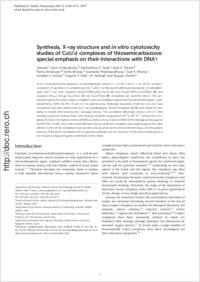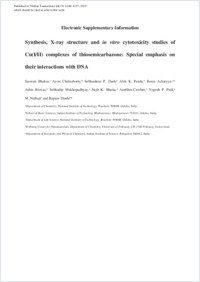Synthesis, X-ray structure and in vitro cytotoxicity studies of Cu(I/II) complexes of thiosemicarbazone: special emphasis on their interactions with DNA
- Saswati Department of Chemistry, National Institute of Technology, Rourkela, India
- Chakraborty, Ayon School of Basic Sciences, Indian Institute of Technology Bhubaneswar, Bhubaneswar, India
- Dash, Subhashree P. Department of Chemistry, National Institute of Technology, Rourkela, India
- Panda, Alok K. School of Basic Sciences, Indian Institute of Technology Bhubaneswar, Bhubaneswar, India
- Acharyya, Rama Department of Chemistry, National Institute of Technology, Rourkela, India
- Biswas, Ashis School of Basic Sciences, Indian Institute of Technology Bhubaneswar, Bhubaneswar, India
- Mukhopadhyay, Subhadip Department of Life Science, National Institute of Technology, Rourkela, India
- Bhutia, Sujit K. Department of Life Science, National Institute of Technology, Rourkela, India
- Crochet, Aurélien Fribourg Center for Nanomaterials, Department of Chemistry, University of Fribourg, Switzerland
- Patil, Yogesh P. Department of Inorganic and Physical Chemistry, Indian Institute of Science, Bangalore, India
- Nethaji, M. Department of Inorganic and Physical Chemistry, Indian Institute of Science, Bangalore, India
- Dinda, Rupam Department of Chemistry, National Institute of Technology, Rourkela, India
-
17.03.2015
Published in:
- Dalton Transactions. - 2015, vol. 44, no. 13, p. 6140–6157
English
4-(p-X-phenyl)thiosemicarbazone of napthaldehyde {where X = Cl (HL¹) and X = Br (HL²)}, thiosemicarbazone of quinoline-2-carbaldehyde (HL³) and 4-(p-fluorophenyl)thiosemicarbazone of salicylaldehyde (H₂L⁴) and their copper(I) {[Cu(HL¹)(PPh₃)₂Br]·CH₃CN (1) and [Cu(HL²)(PPh₃)₂Cl]·DMSO (2)} and copper(II) {[(Cu₂L³₂Cl)₂(μ-Cl)₂]·2H₂O (3) and [Cu(L⁴)(Py)] (4)} complexes are reported herein. The synthesized ligands and their copper complexes were successfully characterized by elemental analysis, cyclic voltammetry, NMR, ESI-MS, IR and UV-Vis spectroscopy. Molecular structures of all the Cu(I) and Cu(II) complexes have been determined by X-ray crystallography. All the complexes (1–4) were tested for their ability to exhibit DNA-binding and -cleavage activity. The complexes effectively interact with CT-DNA possibly by groove binding mode, with binding constants ranging from 10⁴ to 10⁵ M⁻¹. Among the complexes, 3 shows the highest chemical (60%) as well as photo-induced (80%) DNA cleavage activity against pUC19 DNA. Finally, the in vitro antiproliferative activity of all the complexes was assayed against the HeLa cell line. Some of the complexes have proved to be as active as the clinical referred drugs, and the greater potency of 3 may be correlated with its aqueous solubility and the presence of the quinonoidal group in the thiosemicarbazone ligand coordinated to the metal.
- Faculty
- Faculté des sciences et de médecine
- Department
- Département de Chimie
- Language
-
- English
- Classification
- Chemistry
- License
-
License undefined
- Identifiers
-
- RERO DOC 255764
- DOI 10.1039/C4DT03764B
- Persistent URL
- https://folia.unifr.ch/unifr/documents/304384
Other files
Statistics
Document views: 84
File downloads:
- pdf: 178
- Supplementary material: 163

